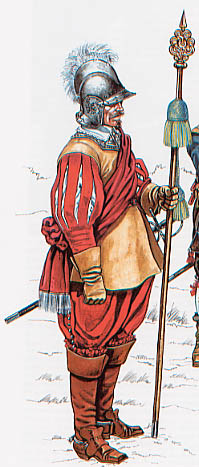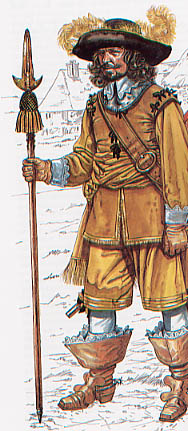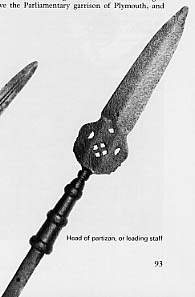| Author |
Message |
Chris Last

|
 Posted: Sun 28 May, 2006 6:52 pm Post subject: Leftenant's Leading Staff Posted: Sun 28 May, 2006 6:52 pm Post subject: Leftenant's Leading Staff |
 |
|
I'm looking to gather information and/or pictures for a leftenant's leading staff. As described in the Trayned Bandes of London's documentation the badge of office of a Leftenant in the Bandes was a 'leading staff'. Unfortunately the information I have on them is not specific to what they were at all. Here's what I have so far:

Artist rendition of Leading Staff is in the middle
| Quote: | | A leading staff is a baton (It may also have been akin to a half-pike SEB) |
Leftenant from the Lant Roll with what seems to be a half pike.
Leftenant of Foote from the Lant Roll with what seems to be either a baton or pistol.
| Quote: | The most compelling piece of evidence that archaeologists have found Gosnold's grave was the discovery of a decorative captain's leading staff that was ceremoniously placed along one edge of the coffin lid. "We have never found any other ceremonial objects in Jamestown burials, so we know this was someone very special," Kelso said. He added that coffin burials were traditionally used for people of higher status.
The Jamestown Captain is also the same age as Gosnold when he died. Owsley determined that he was a European male who died in his mid-to late-30s. Gosnold was 36 when he was buried in 1607 at Jamestown, Virginia.
Archaeologists found the burial under a pit filled with artifacts that date to the 1630s and an earlier post hole which suggests that the interment was long forgotten and was probably from the early years of the settlement. It was also aligned with the west wall of the 1607 fort.
Capt. John Smith credits Gosnold as the prime mover of the colonization of Virginia. Gosnold was the principal promoter and vice-admiral leader of the Jamestown expedition. On April 10, 1606, Gosnold obtained an exclusive charter from King James for the Virginia Company to settle Virginia, and he was captain of the Godspeed, one of three ships in the fleet and served as one of the six members of the original governing council. Gosnold is considered one of the most influential and moving spirits behind English-American colonization. He also explored New England, named Cape Cod and Martha's Vineyard, and colonized one of the Elizabeth Isles. |
I'm hoping to make/get one made as my position with my Trayn'd Bande group is the Leftenant. Thanks in advance for any help!
" Hang fires are all fun and games untill someone gets their eye poked out... by charging calvary." - J.Shoemaker
Chris Last
GSM-Bristol
http://www.gsmbristol.org
|
|
   |
 |
Gordon Frye

|
 Posted: Sun 28 May, 2006 9:48 pm Post subject: Posted: Sun 28 May, 2006 9:48 pm Post subject: |
 |
|
Chris;
The only info I've seen is from the Lant Roll, so I'd be very interested in what you can come up with. I will ask a few well-read parties to see if they know anything about them.
Good luck in this one!
Allons!
Gordon
"After God, we owe our victory to our Horses"
Gonsalo Jimenez de Quesada
http://www.renaissancesoldier.com/
http://historypundit.blogspot.com/
|
|
    |
 |
|
GG Osborne
|
 Posted: Mon 29 May, 2006 8:53 am Post subject: Posted: Mon 29 May, 2006 8:53 am Post subject: |
 |
|
Dear Chris:
The Early Stuart "leading staff" was, of course, the forerunner of the Spontoon which developed later in the 18th century as a badge of office as well as a useful extension weapons for otherwise (sword excepted) unarmed officers during the evolutionary period of the plug cum socket bayonet. The "leading staff" seems to have developed in Germany from the boar spear, a fairly broad-bladed weapon used by the nobility for hunting - hence its possible connection with officerdom. Harold Peterson in "Arms and Armor in Colonial America" illustrates an "officer's spear" on a rather ornate pole with an etched head to which he cites Germanic origins and a mid-16th century date. [ page p95} There are no quillons which is common if the derivation is from the hunting spear where the issue wasn't to prevent penetration but to literally spit the prey. I believe this example is exactly what you are looking for. To quote Peterson: " in 1628 the settlers outfitting for the expedition to found the Massachusetts Bay Colony purchased ' 2 partizans for captain and lieftetant.' " He explains that the use of the term "partizan" is for basically the pre-spontoon type of weapon more highly resembling a spear. Jacques Le Moyne (in the abortive French expeditons to Florida) mentions such weapons that were covered by velvet and studded with tacks replete with tassels. Also, check out the painting of the triumphal entry of King Charles II into London from the Tower to Whitehall, 1661, by Dirch Stoop. This important painting shows the King's immediate bodyguard leading the Yeoman Warders, each of which is carrying a crimson velvet (?) covered staff with ornamental tacks and a gilt spear head. These weapons are distinct from the halbards of the Warders and have a very elaborate, frankly, over-the-top star-burst guard. However, they are obviously signs of priviledge and rank / position. [ See Antonia Frasers "Royal Charles" for the detail of this scene.] Hope this helps a bit, my friend.. George Osborne
So I would venture that and 6-7 foor pole with a symmetrical head culminating in a point, fairly broad-bladed and, for lack of a better term "squat" - highly decorated to utilitarian should be right.
|
|
  |
 |
Chris Last

|
 Posted: Tue 30 May, 2006 1:43 pm Post subject: Posted: Tue 30 May, 2006 1:43 pm Post subject: |
 |
|
Thank you very much for the information! The item I have right now and was planning on using for the head now seems a bit small.
So from the descriptions it sounds like something more along the lines of MRL's Hewing Spear head with some minor tweaks woudl be appropriate. Sound about Right?
 Attachment: 11.18 KB Attachment: 11.18 KB

MRL's Hewing Spear
 Attachment: 95.01 KB Attachment: 95.01 KB
New Pike Heads our group purchased [ Download ]
" Hang fires are all fun and games untill someone gets their eye poked out... by charging calvary." - J.Shoemaker
Chris Last
GSM-Bristol
http://www.gsmbristol.org
|
|
   |
 |
Sean Flynt

|
|
   |
 |
Sean Flynt

|
 Posted: Tue 30 May, 2006 5:20 pm Post subject: Posted: Tue 30 May, 2006 5:20 pm Post subject: |
 |
|
Have you seen these images? They're from the very nice book The English Civil War, 1642-1651: An Illustrated History.
The first image below is titled Officer, Trained Bands, 1642. He carries a true leading staff, with gilded head, based on one depicted in a portrait of Sir Nicholas Crisp by Cornelius Jansen.
The next image depicts a Captain of Gamul's Regt. His weapon, a shrunken partisan is said in the caption to be "...more functional than the decorative 'leading staff'..." The tassel color matches the regimental livery, so keep that in mind when you make your tassel.
The final image is of an actual surviving leading staff head of the period.
 Attachment: 43.09 KB Attachment: 43.09 KB

 Attachment: 47.17 KB Attachment: 47.17 KB

 Attachment: 12.98 KB Attachment: 12.98 KB

-Sean
Author of the Little Hammer novel
https://www.amazon.com/Little-Hammer-Sean-Flynt/dp/B08XN7HZ82/ref=sr_1_1?dchild=1&keywords=little+hammer+book&qid=1627482034&sr=8-1
|
|
   |
 |
|
GG Osborne
|
 Posted: Tue 30 May, 2006 6:19 pm Post subject: Posted: Tue 30 May, 2006 6:19 pm Post subject: |
 |
|
Dear Chris: Previous pictures of the partizan staff are very nice. I noticed that this style of partizan is available as a custom order from www.arms-n-armor.com . I have finally been able to shap a shot of the boar spear / leading staff I mentioned from Peterson. I hope this helps you as well. Not as fancy as the partizan but almost certainly earlier. Good luck with everything! George Osborne
 Attachment: 29.15 KB Attachment: 29.15 KB
[ Download ]
|
|
  |
 |
|
J Willett
Location: Geelong Victoria Australia Joined: 09 Jan 2006
Posts: 6
|
 Posted: Wed 31 May, 2006 6:48 am Post subject: Posted: Wed 31 May, 2006 6:48 am Post subject: |
 |
|
Are you looking at an English Civil War period leading staff?
If so I would refer you to an excellent publication "Arms & Armour of the English Civil Wars" by David Blackmore printed by the Royal Armouries ISBN 0-948092-12-2.
In this book are listed most of the common types of weaponry and armour used during the English Civil Wars with photos of the items held at the Royal Armouries and from other collections.
Under staff weapons Pikes, Halberds, Leading Staffs and Bills are described, here are pictures of a partisan and two leading staffs from this book:
According to Blackmore the Partisan was the staff weapon of the lieutenant and the Halberd that of the Sergeant. In the New Model Army Partisans where being issued at the rate of 10 per regiment which was the same number of lieutenants that these units where supposed to have. The leading staff, Francis Markham writing in 1622 also refers to these as feather staff, is a lightened version of the Partisan and he further goes on to state:
`The Leading Staff mentioned earlier is not strictly a weapon at all, although at the Battle of Cheriton in 1644 a Parliamentarian cavalry officer, Captain Flemming, was wounded by one. Interestingly the account was of Cheriton which records this incident refers specifically to “a captain’s leading staff” and indeed by this time it had become a recognised badge of rank for captains. Few leading staffs have survived to the present day but two fine and very different examples are preserved in the Royal Armouries (Figure 102).”
I addition to Mr Blackmore’s above mentioned work I would also suggest you look further into the album section of this site as there are numerous examples of partisans and a couple of leading staff type weapons pictured, such as these:
http://www.myArmoury.com/albums/displayimage....amp;pos=63
http://www.myArmoury.com/albums/displayimage....amp;pos=62
Finally a note from the English sword master George Silver writing in the 1599 in his “Paradoxes of Defence” he states:
“The Short staff or half Pike, Forrest Bill, Partisan, or Glaive or such like weapons of perfect length have the vantage against the Battle-axe, the Halbard, the Black-Bill, the two handed sword, the Sword and Target, and are two Swords and Daggers, or two Rapiers and Poiniards and Gantlets, and for the long staff and Morris Pike.”
More importantly as a reference to length he states earlier that:
“To know your perfect length of your short staff , or half Pike, Forrest Bil, Partisan, or Glave, or such like weapons of vantage and perfect lengths, you shall stand upright, holding the staff upright close by your body with your left hand, reaching with your right hand your staff as high as you can, and then allow to that length a space to set both your hands, when you come to fight , whre in you may conveniently strike, thrust, and ward, & that is the just length to be made according your stature. And this note that these lengths will commonly fall out to be eight or nine foot long………..”
In conclusion from what I have read it would seem that for the period 1600 to 1650 in the London Trained bands the following would seem be appropriate though not totally binding:
Sergeant – Halberd
Lieutenant – Partisan
Captain – Leading Staff
J. Willett.
 Attachment: 57.85 KB Attachment: 57.85 KB
[ Download ]
 Attachment: 69.57 KB Attachment: 69.57 KB
[ Download ]
|
|
   |
 |
Chris Last

|
 Posted: Wed 31 May, 2006 8:02 am Post subject: Posted: Wed 31 May, 2006 8:02 am Post subject: |
 |
|
Again, thank you all!
The specific time frame I am aiming for is Pre-Armada English trayn'd Bandes ( 1570-1588-ish). From the descriptions and great pictures found thus far it looks like for that time frame I am looking at a cross between a boar spear and a partisan.
I also found this quote from Marham: "The lieutenant should carry a fair gilt partisan richly trimmed, not being above twelve inches of blade, sharp and well steeled.”
Sean-
Thanks for the reminder about the wrap. I've got some blue and red velvet slated for the project! 
" Hang fires are all fun and games untill someone gets their eye poked out... by charging calvary." - J.Shoemaker
Chris Last
GSM-Bristol
http://www.gsmbristol.org
|
|
   |
 |
|
|
You cannot post new topics in this forum
You cannot reply to topics in this forum
You cannot edit your posts in this forum
You cannot delete your posts in this forum
You cannot vote in polls in this forum
You cannot attach files in this forum
You can download files in this forum
|
All contents © Copyright 2003-2025 myArmoury.com — All rights reserved
Discussion forums powered by phpBB © The phpBB Group
Switch to the Basic Low-bandwidth Version of the forum
|

